
This review may contain spoilers
"Patience is all" but might not be enough to help you enjoy this movie
The Iron Fisted Monk was Sammo Hung's first directorial endeavor. He also wrote the script with the help of Wong Fung and served as the martial arts director. I'll chalk this shaky movie up to a first-time effort.Sammo played Hawker/Husker/Luk (depending on the version you watch), a man studying at the Shaolin temple to become skilled enough to enact his revenge. His uncle, the ever-present Hao Li Jen, was killed by a bunch of Manchus looking for trouble at his food stand. Chen Sing as San Te/Tak, the Iron Fisted Monk, sent Hawker to be trained so that he could help the common Han folk. James Tien made a brief appearance as Hawker's instructor before Hawker left on his revenge quest.
Hawker met up with Lo Hoi Pang as Ah Niu/Liang after the dye worker's sister had been raped by Fung Hak On, the Big Bad Manchu. Hawker trains the dye workers in kung fu so that they can defend themselves. Wang Hsieh later shows up as a baddie wearing what looks like a hermit's wig and beard and wielding a kung fu metal yo-yo. When Wang Hsieh and Fung Hak On make a bid to take over the dye factory it becomes apparent just how ineffectual Sammo's training was. At that point Sammo and Chen Sing decide it's time to do some tag team action on the baddies.
Truthfully, the story wasn't any more convoluted than most kung fu movie plots. What I had a problem with was the gratuitous nudity and not one, but two rape scenes. The first was one was appallingly long and graphic. Sammo wasn't known for nudity in the films he directed, maybe he needed to get it out of his system, but the scenes were not warranted in a movie that also had quite a bit of slapstick comedy.
What worked for me in this film were the fights. Sammo and Chen Sing were fun to watch fight together. Chen Sing rarely played the good guy. I almost didn't recognize him at the start of the film without his mustache. Plus, as a monk, he had his shirt on, Chen always found an opportune moment to take it off during his movies. Spoiler alert—by the final credits the shirt had come off! He also smiled and not with the "I just burned down an orphanage" smile he usually had as a baddie.
Chen Sing was still quick and performed a nice splits stunt in the final fight. Sammo showed off his acrobatic skills in an early fight, flipping and somersaulting. The fights were fairly quick and creative, Sammo is always entertaining in a throw down. Several kung fu styles were used including, mantis, snake, and tiger. There were a couple of gory scenes in the fights for those who are sensitive. The movie was populated with stuntmen and actors who would go on to star in their own movies later. Hsiao Ho played at least three different roles---in a beard or sans beard he could be seen in the background often even after one of his characters had previously been killed.
The Iron Fisted Monk was an uncomfortably uneven film. The comedy felt out of place with the numerous deaths and sexual assaults dominating the screen. The character whose sister was brutally raped and committed suicide afterwards was frolicking about with Sammo in a brothel not long after as if nothing had happened. A character would be ready for a revenge rampage and then like a dog when someone yells "Squirrel!" would become distracted and then it was all fun and games. There was little continuity of mood and action. It's too bad because the combination of Sammo and Chen was entertaining. Unless you are just really in the mood for a Sammo Hung movie you haven't watched you might be better off watching one of the others in his long list of credits.
6/3/23
Was this review helpful to you?
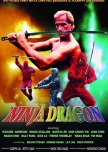
This review may contain spoilers
What if he pulls 3 kings?
Godfrey Ho stitched together a Frankenstein's monster from the 1982 film Dark Trap starring noted Taiwanese actor Chang Kuo Chu and new Hong Kong footage starring Richard Harrison as a ninja extraordinaire. I'm not sure if Ho's notorious dice and splice ninja films were ever supposed to make sense, this one sure didn't.Around 70% or more of the movie was footage from Dark Trap, a Taiwanese gangster film. But when Godfrey Ho waves his magic scissors and needle, now Harrison and Paulo Tocha AKA Bruce Stallion are pulling the gangsters' strings in a deadly game with each other. After Harrison's Gordon beats Tocha's Paul and a bunch of his cronies in a game of cards, Paul has Gordon's gangster friend murdered. The gangster's daughter, Phoenix (Lily Lan), takes over with a little help from Dragon (Chang Kuo Chu). Fox Chan (Miao Tien) decides this is a good time to try a takeover and the gang war is on. Interspersed in the dark film are ninja scenes where Gordon in his camo costume and heavy-duty guyliner confronts individual bad guys and takes them out ninja style. Chiang Tao wasn't in Dark Trap but was brought on as bad guy victim #1 Black Tiger in this flick.
This is one of those films where maybe once upon a time you were watching a boring or run-of-the-mill gangster film and thought, "I wonder if ninjas inserted randomly into the film would make it better?" Better, no. Hilarious, yes. It was apparent aging beefcake Richard Harrison with his graying porn stache was not performing any of his stunts. He'd pose shirtless and then cover up head to toe and let the stuntman take over. This is around the time Tocha starred in Jean Claude Van Damme's Bloodsport as the fierce Muay Thai boxer, but he was covered up, too, when he finally faced off with Harrison. I wish they'd showed him in action sans ninja costume.
Dark Trap was its own brand of demented fun. It was difficult to tell the gangs apart as nearly everyone wore dark suits and hats as if they were in 1930's Shanghai. There were not one, but two suicides committed by the victim bashing their own head in. The television version I watched blurred out the gore and gratuitous nudity, thankfully. There were numerous double-crosses and "surprise" murders. Lily Lan did make for a proper mob boss and Miao Tien seemed to relish his devious role.
The Dark Trap part of the movie was all gun play while the magical ninjas appeared in puffs of smoke and wielded throwing stars, darts, swords, and chains. I couldn't tell you which was better, both could be comically bad. The dubbing was awful, even for the English dubbing for English speaking characters! And here's a sample of the atrocious dialogue, "You must use the Chinese against the Chinese. You're playing the Game of Death!"
If you are looking for something completely absurd to watch and have nothing else to do, or love Ho and Harrison cheap ninja smash-ups, this is for you. Otherwise, it might be best to change the channel and see what else the late, late, night movies are offering.
5/17/23
Was this review helpful to you?
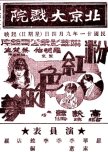
This review may contain spoilers
A pink nightmare
A Dream in Pink was an early Cai Chu Sheng film about learning the grass is not always greener on the other side, even in a black and white movie.Luo Wen is a struggling novelist with a dutiful and loving wife. Along with seeing to his needs, Su Yun cares for their daughter and teaches students in the room next door. He becomes petulant when Su Yun is not happy about him bringing home several expensive hair combs for her. Cue the cranky landlord who is upset about their late rent. Angry that his wife doesn’t appreciate him he heads out to a fancy club and meets socialite Hui Lan. Hui Lan takes an immediate liking to him and before long he is spending not only nights in the club but also Hui Lan's bed. Su Yun tries to be sympathetic to his writerly needs and ends up being handed divorce papers as payment for her patience and kindness. Luo gains custody of their daughter, something Hui Lan is not thrilled about.
Su Yun finds a job teaching on the outskirts of Shanghai. She misses her daughter and see her everywhere. Likewise, her daughter misses her. Luo becomes immersed in his writing much to Hui Lan's chagrin but it doesn't stop her club hopping ways. Soon Luo understands the meaning of debt and a spendthrift wife. The roles are reversed as he tries to keep their heads above water. When he does earn money from his book, she runs off with it and another man.
I wish that this was the karmic ending he received, but in 1932 China, it would not have been considered a happy ending. And this film was determined to have the cutest ending ever.
The film was faded and though not on purpose was in shades of pink and purple. Unlike many silent films I've seen from this time there was a plethora of intertitles. I had no difficulties following the story. Even with the pocking and fading, you could tell the director had used some beautiful scenery and settings.
My biggest problem with the film was the finale.
Ending Spoiler ahead
-
-
-
-
-
When she found out that Luo was broken financially and emotionally after his second wife left him, Su Yun wrote a book under his name titled "Tears of an Abandoned Wife" which the publisher loved. In fact, when the publisher found out the truth he told Luo, "No wonder the story is so moving." Ouch! Even when he reconciled with Su Yun it would have been surprising if this man's fragile ego could handle his wife being a better writer than him.
Luo Wen learned that the decadent and frivolous life of the clubs was not a sound foundation for a life. He also learned his wife was not lacking the ability to have fun, she was simply providing for her family at the most basic level and always seeking ways to please him as well. The spoiled socialite, like himself, had only been looking for self-gratification. Perhaps, he truly learned his lesson. For his wife and daughter's sakes I hope so. I have trouble shaking my 21st century opinion. For me, although A Dream in Pink was an interesting silent film, it would have benefited from a wife who wasn't a martyr and could have thrived on her own as a successful writer. Instead, just like a wayward dog that left the safety of his food bowl and porch, Luo Wen went back home where Su Yun gratefully accepted him. He may have gained something from his arduous life lessons, but I'm not sure she did.
5/16/23
Was this review helpful to you?
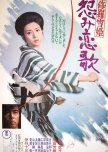
Lady Snowblood 2: Love Song of Vengeance
1 people found this review helpful
This review may contain spoilers
Be careful what you wish for!
Lady Snowblood: Love Song of Vengeance saw the return of Kaiji Meiko as the titular character. Where the original film was tight and thrilling the sequel felt overly talky and plodding. The story of personal vengeance was replaced with political maneuverings and corruption.The story begins with Japan's success in the Russo-Japanese War with much singing and cheering. The cheering gives way to anger and riots as inflation skyrockets and people struggle to feed themselves. Lady Snow (she dropped the Blood part but no one heeded her request) after surviving her blood-soaked battle in the first film is on the run in the second. Tired and betrayed one too many times, she surrenders. Sentenced to die for her 37 unrepentant killings she's saved from the hangman's noose by a shadowy secret police. They hire her to spy on an activist and once she finds the evidence he has regarding their corrupt activities she is to kill him. Big mistake. The activist, Ransui, reveals the evil ways of the secret police and she joins him. When he is captured and she is injured, the fate of the secret police and their official benefactors is sealed.
Despite the high stakes in the story, I found myself struggling to concentrate through much of the middle of the film. It didn't help that the majority of characters simply weren't likeable. Even the people trying to bring down the secret police were extremely flawed individuals.
The sword fights were standard 1970's swing and fall fare. As in the first film, buckets of red dye #40 spewed during the fight and torture scenes. Lady Snowblood must have had a need for symmetry. One bad guy who had lost an eye, lost another one after fighting with her. She "dis-armed" a one-armed villain as well. The fights were as violent but not as stylish as the first film. Which sums up the movie in general. It wasn't as stylish or polished as the original.
I'm not sure where the title came from. Aside from a gratuitous sex scene between the activist and his wife, the woman he stole from his brother, there wasn't any lovin' going on. Whereas Meiko seemed intense and focused in the original, she seemed almost distracted in the sequel until the fighting began. Snow certainly wasn't casting any longing looks toward the scoundrels in the story. Like her, I didn't find any of them that compelling either.
Lady Snowblood: Love Song of Vengeance paled in comparison to its predecessor in terms of acting, fighting, style, and story. Kaiji Meiko still managed to make Lady Snowblood a fascinating character, but she wasn't given enough to do to carry the movie on her narrow shoulders this time. While I found the movie watchable, it won't be memorable.
4/29/23
Was this review helpful to you?

This review may contain spoilers
Alone again, naturally
An Autumn Afternoon was director Ozu Yasujiro's final film. The main character and Ozu were in the late autumn of their lives, far closer to winter than summer. Somehow, this film so reminiscent of Late Spring, with a father facing solitude as his children were leaving home was a fitting ending for the great writer and director.Ryu Chishu, an Ozu regular, once again played a father deliberating marrying his youngest daughter off. His character, Hirayama Shuhei wasn't in any hurry to find a suitor for her until he and his buddies held a reunion for an old teacher. The teacher's middle-aged daughter still lived at home and worked in their noodle shop taking care of her father. Instead of feeling sorry for the lonely, sad woman who was well beyond the age of marriage, they pitied the old man. These were the older men who mercilessly teased the one man in their group who had married a woman his daughter's age, worrying she would be the death of him. Most of the women in the offices were young because by the age of 24 they were supposed to marry and quit their jobs. As Shuhei makes the decision that Michiko should marry soon, his other children are only worried for him, not whether Michiko would be happy and well cared for.
Ryu did a superb job as always encompassing the character designed for him by Ozu. This time his daughter was played by Iwashita Shima who was actually age appropriate for this role. Young and vivacious, Michiko was in no hurry to marry but also was a dutiful daughter and followed her father's lead which Iwashita portrayed perfectly. It seems like there is always a strange casting in Ozu movies when it comes to age. Tono Eijiro(the old teacher) was a year younger than his movie daughter Sugimura Haruko!
The three older men felt like they could have been the school boys from Ozu's earlier films. All grown up, but still mischievous and pulling pranks on each other. I did find it oddly disturbing how often they made innuendos about the one man's very young wife. Though everyone was worried about Shuhei being alone, in reality he spent long hours at the office and then seemed to go out drinking with his friends every night. Michiko stopped making dinner for him and her brother because they never called to say if they were not going to be eating at home after she had gone to the trouble to cook for them. Though it was Shuhei we were guided to feel sorry for, it was the women who earned my pity. Michiko had little say about her life which was mostly laid out for her by men. The old teacher's daughter had been used by her father as a surrogate housewife to care for him after his wife died. Michiko's sister-in-law had to deal with a selfish husband who spent money recklessly. Shuhei was proud of his daughter for handling a rejection so well, then found out she had cried. Thankfully, Ozu had allowed her to be human and experience sorrow even for a moment.
This is the first Ozu film I've seen where WWII was mentioned so much. Shuhei had been the captain of a destroyer and met a crewman in a bar. The crewman lamented their loss, saying if they'd won those blonde haired, blue-eyed Americans would be play the samisen now instead of the young Japanese dancing to rockabilly. Shuhei blithely tells him then it's lucky they lost. Ozu rarely delved into the past with his characters. They lived and dealt with problems where they were---in the present.
Regardless of my misgivings for the lack of autonomy for the female characters, this was Ozu's world, not mine, and the old childless bachelor was feeling the sting of loneliness after the recent death of his elderly mother. Despite the characters in the film doing what they could to ameliorate their circumstances, there would always be suffering. Ozu never flinched from two difficult life lessons: Life is short and loneliness is hard. Shuhei bitterly said, "…sons are best…No point in having a daughter…" His friend understood the meaning beneath when he responded, "Boy or girl, it's all the same. They all go sooner or later." It's in the nature of children to grow up and leave the nest no matter how much love, attention, and money has been given to them…just as their parents did. One day Michiko may face solitude, maybe not in an Ozu film because the women all seem to die young, but parents all tend to fade from their children's lives. Old age is filled with empty, quiet rooms.
In the final scene, Shuhei sang from a military song and then said, "I'm all alone." The camera took one long loving look at Ozu's meticulously decorated set and the actor who had accompanied him for so long on their theatrical journey as Shuhei poured one last glass from Ozu's ubiquitous teapot. A fitting ending indeed.
4/26/23
Was this review helpful to you?

This review may contain spoilers
Interesting history and beautifully shot
Flavorful Origins visits the Chaoshan region in 20 approximately 10 minute segments featuring a different ingredient or process elegantly shot. The ingredients are shown from harvest or development to how they are prepared. Most of the dishes are traditional but there are also a few shown from chefs using the ingredients in innovative ways.Whether olives, oysters, or oranges, the products are shown being harvested and why the particular product thrives there. Other segments deal with processing whether it is fermentation, brining, grinding, or pulverizing. Local markets, farmers, fisherman, and cooks are highlighted.
The camera shots narrow in displaying how sumptuous, juicy, or elastic the foods may be. Everything is colorfully and lovingly gazed over with the camera.
I enjoyed the history briefly told about the different products and processes. It was also interesting how the people of a region made the most of the resources around them to flavorfully feed themselves in ways other regions don't always use.
The beautifully shot and described segments give an outsider a brief glimpse into the origins and flavors, cooking styles, preserving techniques, and farming and fishing methods used to produce food that has fed and nourished the local populace for centuries. Nice bite size morsels, easily digested and visually consumed for the casual viewer.
4/22/23
Was this review helpful to you?
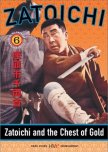
This review may contain spoilers
Zatoichi and the Chest of Gold packed plenty of action and humor into its short running time. Unlike many martial arts films from the time, Zatoichi had excellent choreography and a comprehensible story. This sixth film in the franchise was my introduction to the character and I was quite pleased with the film's quality.Zatoichi, a blind traveling gambler and masseur, as well as a swordsman who has a "lightning sword" visits the grave of a man he killed previously. The man who died was the brother of the young woman, Chiyo, accompanying Zatoichi. The local villagers welcome him to their joyous celebration filled with drinking and singing. They finally have the 1000 gold ryo they owe to the ruthless intendant, giving them some room to breathe and more to eat. Unfortunately for Zatoichi, the gold is stolen in a botched robbery. He was coincidentally seen sitting on the pilfered chest which the bad guys recovered. Chiyo was all too quick to name him as a suspect. Zatoichi talks the villagers into giving him a chance to find the real culprits which the villagers grudgingly agree to. His investigation takes him to a bathhouse with a beautiful woman and later to a gang of men led by the somewhat virtuous Chuji who had also been implicated in the crime. It doesn't take long for our blind hero to track down the real villains, the intendant planning double taxation, his corrupt constable, and the three ronin they had hired. One of the ronin, Jushiro, is a whip wielding baddie determined to duel Zatoichi.
The sword-fights were quick with a minimum of blood spurting. Regardless of the number of opponents, the blind hero cut through them like soft butter. Only the final fight caused him problems as he had to seek Jushiro's weakness in order to best his rival.
From the stylistic opening scenes, Zatoichi was beautifully filmed in color. The sets both indoor and outdoors were well done. As Zatoichi carries a young boy down a mountain at night, the constable's men travel with their identical lit lanterns like a glowing caterpillar along the trail. Quite a stunning sight!
The story gave insights into the swordsman, some favorable and some not. He offered a beautiful woman in a communal bath a massage, saying it was okay because he was blind. He came across more as a dirty old man than sensual or humorous. A prostitute gave him a "massage" and then charged him for it which didn't go over well with him. But he also showed his heroic integrity as he went out of his way to help the accusatory villages knowing they would be unable to come up with more money for taxes which would have been a death sentence for them.
Katsu Shintaro brought the right amount of gravity and humor to the legendary swordsman. After Zatoichi's last fight, beaten and bruised, struggling to walk, you could feel the weight of the character's recent trials. I do wish I had a dollar for every time he mentioned he was only a blind man, I'd have enough to eat out for a week! Jushiro was played by Katsu's real-life brother. Their brutal fight would have been a cathartic way to work out old sibling rivalries.
The film highlighted the plight of the hardworking poor, striving to exist under a system crushing them and the corrupt leaders loading the boulders on their shoulders. Zatoichi was the mythical character who could break through the massive unscrupulousness and ease their burden, righting the wrongs committed against them. Something we might all wish for when life seems unfair. I was quite pleased with my foray into this franchise and look forward to watching other films with the self-effacing and lightning quick swordsman.
4/17/23
Was this review helpful to you?

This review may contain spoilers
"Unless you can fly, there's no way to escape!"
Ti Lung, David Chiang and director Chang Cheh made a number of films together, including one of their earliest, Have Sword Will Travel. Chang Cheh diverged from his usual Buckets 'O Blood format in this film, slowed down, and gave the story and characters time to grow. That doesn't mean there wasn't plenty of red dye #40 used, but he did wait until the last third of the film for the fighting to truly commence.Siang, the dart master, played by Ti Lung and his lady love Piao Piao (the lovely Li Ching) are lounging in a flower covered meadow. It's a typical marriage proposal with Siang throwing a dart at the yellow flower in Piao Piao's hair and nailing it to the tree behind her all while fighting off a dozen bandits. They are on their way to the Invincible Village to help out Lord Yin who is responsible for escorting an imperial treasure of 200,000 silver pieces. Meanwhile, Lo Yi, a poor wandering swordsman is just seeking shelter for the night and stumbles upon a tower where a huge group of bandits called the Flying Tigers are holed up. They are led by none other than Ku Feng as Jiao Hung. Lo manages to avoid a fight and ends up in the Invincible Village. Siang is convinced he's a spy and wants to dispatch him, but his anger might have had more to do with Lo and Piao Piao making googly eyes at each other. Along with setting up the key players for the eventual all-out fight over the silver, the fight for the heart of Piao Piao has begun as well. Who will live, who will die, who will ride off into the sunset, and who will win fair maiden's heart?
The title is a play on the name of an American tv show, Have Gun Will Travel, starring Richard Boone from 1957-1963. Aside from David Chiang's wandering character and his friendship with his horse, the western references were few. This was largely a sword-fighting drama with quality fights for the era. The bad guys also employed chains with knives, bow and arrows, and what looked like metal boomerangs. Yuen Cheung Yan and Tang Chia choreographed the fights which were few early on, but made up for it in the finale. The body count was high by the ending credits. In true wuxia form there was an abundance of trampoline and wire work which for the time looked pretty good. The blood spurting was understated for a Chang Cheh movie, but if it's something you enjoy, there were several slow motion geyser scenes that should quench the most blood thirsty viewer.
A familiar tower which was used in other films and prescient of Bruce Lee's Game of Death idea, had the heroes fighting their way up the different levels manned with weapon wielding bad guys. As much fun as it was to watch the battles, it made little sense for the good guys to detour off the road with their precious cargo of silver to end up at the tower. The movie looked like Shaw Brothers sank more money into this one than many other of their films. The sets were a step up from their disposable sets built for rough and tumble bar fights. While the outdoor filming provided a scenic backdrop for the actors it could be unsettling when it bounced back and forth between nature and the sound stage in the same scene.
The three main actors had a nice chemistry and played off each other well. Ti Lung was confined to playing the man jealous of his rival's sword skills and how his girl gazed at Lo's narrow sword. David Chiang is not a favorite of mine, but he managed to let a few emotions crack through his closed off face. At one point when Lo had to sell his horse in order to eat, you could feel the sense of loss. Both Siang and Lo were unrelentingly proud which became tiresome after a while. Ku Feng really sank his teeth into the charismatic leader of the Flying Tigers. In one scene Ku slithered up to Lo like a snake in the garden and tempted the expert swordsman to join his gang.
The visual quality of Have Sword Will Travel was impressive compared to other martial arts films of the time. The vicious sword fights were well done and the story had real stakes for the fights. The love triangle added emotional depth so often missing in these movies. I was disappointed that we missed out on a friendship or mutual respect developing between the two rivals because that would have set this movie even further apart in quality from other cut and paste kung fu flicks. Instead, there were two prideful men, unwilling to accept help from each other even when it no longer made sense to push each other away. I kept hearing Mony Python's knight saying, "Tis but a flesh wound!" Regardless of this quibble, Have Sword Will Travel with the renowned trio of Chang Cheh, Ti Lung, and David Chiang is one for martial arts movie fans to seek out.
4/11/23
Was this review helpful to you?

This review may contain spoilers
Prison buddy movie missing a coherent plot
Bolo gave star and director Bolo Yeung Sze a chance to play against type. Instead of the bruisingly brutal bad guy the good guy pummels at the end of the movie to show the hero's prowess, Bolo played the big dumb ox. After watching this not once but twice now, I think I like him better as the bad guy.Aside from the synopsis that Bolo and Jason Pai were prisoners sent to be sheriffs in a lawless town where the sheriffs kept getting murdered, I'm not entirely sure what the plot was. Bolo seemed to think he was the sheriff and stumbled into helping people though the townspeople didn't support him with the exception of Lau Hok Nin. Pai spent more time in the brothel or searching for the missing gold that had landed him in jail in the first place. Then the plot tumbled off a cliff and was swept out to sea. Whether the prison buddies were working for good or evil was debatable, although they did find the mastermind behind a sex trafficking ring and the missing gold. The film had bathroom humor and sexual jokes. Most of the jokes came at Bolo's expense.
Sadly, Bolo's fights were mostly kung fu posing, emphasizing his power and size. Pai's fights were quicker and stressed his agility. I'm all for a shirtless Bolo more on the side of good than bad, I just I wish they hadn't made him quite so slow. Jason Pai was engaging as a character and fun to watch fight. The final fight was the best one when a Japanese fighter wearing a metal pan on his head took the two buddies on. When the two combined their skills, it was cute to watch, deadly, but cute.
If you love slap stick humor and don't mind an almost incoherent plot, you could try this one. I'm a big Bolo fan and enjoyed Pai's sly character, but this movie stressed my patience.
3/28/23
Was this review helpful to you?
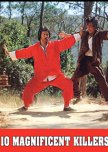
This review may contain spoilers
If you want it, come and get it!
The title 10 Magnificent Killers pretty much sums up the story for this Hong Kong kung fu flick. Two young fighters are trained by two different masters, one a constable and one a criminal with a dark secret. The movie features numerous B level kung fu actors and stuntmen. With four different martial arts directors the numerous fights all looked a little different. Fong Yau who normally plays the bad guy, wrote, directed, produced, and did work as a martial arts director which might explain why he actually played a good guy in this movie!Hsia Chuan (Nick Cheung Lik) was raised by Tu Shu (San Kuai), a cagey master who cons Hsia into signing a contract giving him 50% of his earnings for life. The resident Big Bad, Leng Chieh (Bolo!), begins sending his top ten killers against Tu Shu. Hsia is not afraid of using poison against his enemies, including Hsiao Li's master Lee Yu Wei (Fong Yau). Lee survives and continues training the young Hsiao (Chu Chi Ming) to become a constable. Tu Shu and Hsia are more concerned with collecting the bounty on the killers' heads and how they are going to split it. A beggar uses his stick of doom, a coffin maker shows up literally in a coffin before beginning to fight, and Addy Sung appears as a kung fu fortune teller among the other assortment of killers doomed to die. Tu Shu and Hsia find out where the killers are and begin taking them out one by one until only Bolo is left. Somewhere else in the wooded area, Lee continues to train the marshmallow looking Hsiao. Eventually, all the secrets are revealed and the story comes to a head with the two young fighters meeting and then a rushed ending given the revelations at stake.
Because there were four martial arts directors-Bolo, Cheung, Fong, and San, there wasn't a cohesive fight experience but that might have been a good thing for some fights were better than others. A variety of styles were used such as Snake, Bolo's "I'm not looking at you" style, and a kick-fest for the finale. Nick Cheung Lik and San Kuai were featured in nearly all the fights, some serious, others comedic, and held their own. Chu Chi Ming was a lackluster hero who had little screen time which was no loss.
While the fights came fast and often, the flimsy story doomed the movie to forgettable. Bolo and his terrible mustache couldn't even save this movie. For a short kung fu film it was below average but watchable with nothing terribly offensive. No spurting blood, no nudity (although there was a lead up to an intimate scene), but also no memorable fights. The story could be confusing diluting the big reveal at the end. The main focus of the film was the two guys who poisoned and killed their way through a vicious gang, who weren't much better themselves. I was happy to see Fong Yau play a good guy and I'm a Bolo fan, but I'm not sure that's a recommendation for watching.
3/28/23
Was this review helpful to you?

Tony Jaa delivers a trunk load of Muay Thai fun!
The Protector packed a trunk load of action into a short amount of time. Protector Tony Jaa proved he was up to the tusk when he traveled to Sydney to find his stolen elephants. Ivory few minutes there was a bone crunching action scene with a ton of flipping, twisting and leaping. I promise I'll stop with the elephant puns now.Tony played Kham one of the Muay Thai trained protectors of the elephants that may serve the king. During a celebration, the bull elephant and his calf were stolen and taken to Australia. Kham arrived in Sydney and ran afoul of the law almost immediately. He was fortunate that one of the police officers was Thai and believed his story. Unfortunately for that cop, he was framed for murders the triad committed.
Most of the story was filled with contrivances that were best not looked at too closely. The main thrust of the story was that Kham was willing to go through anyone to find his elephants. This movie was all about the action scenes, and on action scenes, it delivered. The bad guys had an entire army of fighters. Fighters on skates, bikes, motorcycles, armored four-wheelers, with fluorescent bulbs, knives, guns, statues, whips, and/or swords. Tiny Tony also faced seven-foot giants. There were chase scenes involving speed boats and helicopters. There was an intricate scene filmed in one long shot as Kham fought his way through the bad guys' den up several levels of stairway. Though there were numerous long action scenes, none of them felt repetitive. Each setting had its own fight mood. Whether it was Road Warrior futuristic mayhem or meditative murder in a Buddhist temple, each fight brought its own style and weaponry. It would be hard to overstate how amazing the actions scenes were. Jaa was incredibly athletic and acrobatic, doing stunts others would need obvious wire-work or CGI to accomplish. To quote a character from the television show The Wire, "That was some Spiderman sh*t!"
Aside from the narrative issues, the dubbing for this movie was terrible in places. It strained imagination to believe Kham was in Australia with some of the "Australian" accents. Bad guys and bodies appeared and disappeared along with story cohesiveness. The acting was serviceable, as long as no one had to say too many lines. As I said, best to focus on the action scenes and not pay much attention to the rest or you may become needlessly confused or disheartened.
What I learned from this movie: #1 Elephants are loyal family members. #2 Gravity does not apply to Tony Jaa. #3 When in doubt-aim for an enemy's tendons, preferably with a bone of revenge.
If you are wanting a complex and coherent story with character development, this is not it. If, however, you are in the mood for an exciting martial arts movie that includes elephants and has a likeable star, everything else is irrelephant (couldn't help myself!). This is the one to try.
3/20/23
Was this review helpful to you?
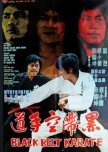
This review may contain spoilers
Black Belt Karate was a Hong Kong-Indonesia joint production with a mixture of Hong Kong and Indonesian actors. Indonesia provided most of the settings, giving some new blood to the standard Hong Kong and Taiwanese kung fu fare. The movie itself could have used a transfusion of screen presence magnetism.The movie began with a goofy character named Tommy arriving in Indonesia from Hong Kong looking for his uncle. He wanted to learn karate at his school, but upon arrival it turned out his uncle had moved and a restaurant had replaced the school. The restaurant owner hired him to wash dishes and do odd jobs. Tommy spent most of his time practicing karate moves and watching the demonstrations at the Golden Eagle martial arts school when he should have been working. He was fired from his job and began work as a cart driver where he bumped into a beautiful girl whose father just happened to own the Golden Eagle. He began work as a janitor at the Golden Eagle and ran afoul of Lamoz, the top coach, who had his eyes on Tan Wei, the master's daughter. After Lamoz put the beat down on Tommy, the comic relief was allowed to begin training. Master Sai believed Tommy was a diamond in the rough and would one day become a great karate expert. Billy Chong, who was only referred to as Second Brother, became good friends with Tommy.
Tommy improved and won a local tournament which resulted in the sore loser picking a fight with him later. After Tommy defeated him, it turned out the fight was against the Golden Eagle rules and Lamoz saw to it that Tommy was kicked out. After Lamoz revealed he wanted to marry Tan Wei so that he would inherit the Golden Eagle, Master Sai kicked him out. Lamoz began work at GA's rival school, the Dragon Martial Arts School. Master Sai became ill and asked Tommy to return. When Tommy was out on an errand, Lamoz brought the Dragon students to the Golden Eagle and terrorized the students and tore down their sign board. Master Sai sent Tommy to Hong Kong to further his studies.
In Hong Kong, Tommy met Bruce Leung as Hsieh Kwong, which set up the best fight in the movie as the two sparred. Tommy returned to Indonesia after finishing his training to find that Master Sai had died when he fought off Lamoz, after the creep tried to rape Tan Wei. The big showdown between Tommy and Lamoz was comically short and failed to give the catharsis the character and the audience deserved. The Dragon school called in a ringer, Lo Lieh, to kill Tommy. Despite Lo Lieh showing up in a fancy black and red cape, it didn't help him in the fight.
This film was an odd one. When the film began with Larry Lee doing a comic relief act, I kept waiting for Billy Chong to show up as the main character since he received top billing on the DVD. Instead, Lee with his less than leading man looks or acting ability was the star. Billy would have his chance soon enough in his movies that followed. Lee had above average martial arts skills and indeed did train in Goju Ryu karate. His moves and choreography were realistic enough in most instances. Bruce Leung also was credited with martial arts direction. I truly enjoyed watching Bruce and Larry spar, it was quick and showed off their kicking skills. With the exception of the final fight and Bruce Leung's fight with Chiang Tao, most of the fights were well above kung fu posing. I'm an unabashed Lo Lieh fan, but despite Lo Lieh being Indonesian, this movie could have used a more skilled karate fighter for the big finale. My dream casting would have been Kurata Yasuaki. As it was, the final fight was a let-down. Most of the fights after Tommy returned to Indonesia were of a lower quality than the earlier parts of the movie.
Black Belt Karate had plenty of fights for martial arts enthusiasts with talented bit players and stuntmen filling in the action. Even though it lacked that special narrative spark and charismatic acting that would have made it more memorable, the movie is still one to try for the different fight style and setting than most of the Hong Kong movies in this era had.
3/20/23
Was this review helpful to you?
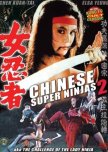
This review may contain spoilers
One ninja star out of four
Challenge of the Lady Ninja had the potential to be so bad it's good and a fun girl power movie, but was bogged down in sexploitation. The film couldn't even pretend to be about empowerment when it featured ninja mud wrestling.Wong Siu Wai, a Chinese woman, had trained for 17 years in Japan as a ninja, becoming the only female ninja in the clan. You could tell she was the only woman because she was the only ninja wearing red. Totally blends and keeps her hidden. Her fellow ninja, Koloder was furious because she beat him and is Chinese. She had to go home to Shanghai when her father was killed by her fiancé who turned out to be a traitor. We all have family problems, but girl had more than her share. Upon returning home and meeting up with the resistance she determines to train some women in the art of being a ninja. Her ninja training included a long session of stretching with gratuitous boob and crotch shots and lots of suggestive moaning. I never knew this was essential to ninja training but discovered ninja mud wrestling was part of the experience. Nothing sexist about this at all. Part of the training included one ex-prostitute who could seduce a man by projecting her body in underwear before him and then transporting out. Wong had the same ability.
Lee Tong had four martial arts bodyguard who dressed like aliens, especially the guy with a scorpion tattooed on his bald head. The women work to kill off the bodyguards one by one which entails a vampire poison bite, dealing with a heat seeking boomerang, and an oil or water fight with two women stripping down to their bathing suits hidden under their clothes. Always be prepared! A dude in a Skeletor mask even appeared out of the blue to help them on occasion. I'm not making this up. The final showdown with Koloder was bizarre and had the abrupt ending so many 1970's kung fu movies employed.
Elsa Yang made a serviceable campy ninja, she just wasn't served well by the script. Chen Kuan Tai as her target and ex-fiancé played the debonair traitor always jauntily dressed in suits. The kung fu movie star had one short fight near the end. Robert Tai played the strange bodyguard with tattoos and blue lipstick, leaning into the oddity of the role.
The movie was set during the Japanese occupation, so 1930's or 40's. You would never know that by looking at it. They did work in a few "ye olden times" costumes, but they were interspersed with modern (70's or 80's) clothes and hairstyles, not to mention the many bikini scenes. Modern cars were shown numerous times as well. I laughed out loud when they played Darth Vader's intro music from Star Wars with the traitor's introduction. The rest of the music was of the bow-chicka-bow-wow generic synthetic variety. There are a couple of versions out there, one where the traitor is the female ninja's fiancé, the other where he is her brother. Does not improve the story either way.
The fights were the swish and fall sword fights, most of the others defied the laws of physics. One underground fight was mind bending. Bad wire-fu was often used and plenty of colorful exploding smoke bombs were thrown. The fights really were quite dreadful. Oh, and lots of jedi, I mean ninja mind tricks.
With so many women in the cast I wish that I could recommend this movie. I found it to be hugely disappointing. Instead of being a movie about women ninjas for women to also enjoy, it was a titillating view of how men want to see women ninjas train and fight. Only for a niche crowd, one of whom I'm not.
3/14/23
Was this review helpful to you?

This review may contain spoilers
Blood for Blood
Ti Lung played a dual role in The Revenger, a film that covered twenty years. The title was a misnomer because in neither the father role nor the son role did he truly play a vengeful character. That's not to say there wasn't plenty of revenge to go around, but at least for the title character, revenge was not his defining characteristic.Chou Tu is a force for good, protecting the abused and downtrodden. This puts him at odds with Mao, a ruthless and underhanded villain. Chou rescues the lovely Shih Szu and ends up taking her as a mate. After being murdered in an explosive ambush, Shih Szu is rescued by two comedic kung fu experts who help her to raise her baby. With Chou Tu gone, Mao fully established his power and destroyed a family who were not loyal to him. The neutral swordsman, Ling Yun, takes the baby daughter to raise while Mao grabs the family's son to raise for vengeful purposes.
Eighteen years later, Shih Szu tells her son, Chou Shu about his father's murder and how his bones are scattered amongst the treacherous villains. Shu is bent on revenge but on her deathbed his mother makes him promise to not seek revenge only to retrieve his father's bones so that she and the man she loved could be buried together. The little girl grew up to be Hsu Feng whose only desire is to destroy those who killed her family while her brother grew up to be Dorian Tan (with no kicking abilities!) who is loyal to the dastardly Mao. It doesn't take long before the new generation is set on a collision course and the bodies around them start to stack up. Though Chou Shu kept his promise there couldn't have been more death in this film had he gone on a purposeful murderous rampage.
The fights used more weapons than actual hand to hand and were more comparable to kung fu dancing than fighting. There was quite a bit of kung fu posing and conversely, sped up fights as well. Why they had Dorian "Flash Legs" Tan play a milquetoast character who only used a whip, I'll never know. His part was extremely small making it seem he might have been filming another movie and only showed up when he had time. Hsu Feng, as the sister, along with her master Ling Yun, were the two most vengeful characters though they didn't have much screen time either. Wong Ching wasn't the most menacing of evil doers and could come across as a sniveling stab you in the back guy instead. Ti Lung as an eighteen-year-old was a stretch but he did give it a good try to distinguish the two characters. Like a less vengeful Inigo Montoya it did become a bit humorous as he kept repeating to each of the numerous villains that he was not there for revenge, only to retrieve his father's bones because no sooner would he utter the words than the bodies would start dropping.
Twenty years' worth of story with numerous characters condensed into 100 minutes made it difficult to emotionally connect to anyone. The second generation had revenge and familial elements that would have made for a more gripping story had they been properly expanded on. It the story is not compelling the fights have to be dynamic and these fights were below average for a 1980 movie. The potential was there, but this was one skeletal script that fell apart.
3/13/23
Was this review helpful to you?
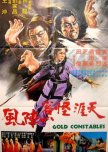
This review may contain spoilers
Lots of high flying action that doesn't go anywhere
A stolen shipment of government gold, a police chief seeking a pardon, not one but two vengeful daughters, murderous bad guys, and evil monks---sounds like enough plot for an old martial arts film---just barely. Carter Wong and Lo Lieh added kung fu credibility to the blade thin story which required non-stop action to be of interest.Lo Lieh tricks some petty thieves into gaining him access to the government's gold warehouse and then leaves none alive. Lung Fei, his loyal henchmen, helps him to clean up. Later, an always stoic Carter Wong, enters Lung's gambling establishment and says his name is The North Wind. Lung is so impressed with the way Carter handles a fight he gives him a job. What kind of job and why does he trust him so quickly? Story convenience. Two different women, Nancy Yen, the daughter of two innocent people killed during the robbery and Chi Lan, the daughter of one of the murdered petty thieves, butt heads working against each other for the same goal of avenging their families. James Tien shows up as Lo Lieh's #1 ruthless minion. Miao Tien as one of the Three Tigers works to discover where the gold is with his two buddies. People are pretty touchy and nearly everything results in a fight with everyone either looking for the gold or vengeance.
The fights varied, some were below standard for this time frame, others were better depending on who was fighting. Nancy could almost be seen counting her steps in a couple of fights. Chi Lan, who only made one movie, was more fluid and athletic. Their choreography incorporated too many unnecessary jumps simply to add motion. Generally, if Lung Fei, Carter, Lo, or James were in a fight scene they flowed better. These guys were old pros at fight choreography by this time in their careers. Much of it was the of the strike, block, lock method, some faster than others. The weapon fights used a variety of styles amid wire work. The monks utilized a giant lantern with old UFO sounds which could spin out poisoned darts. Per usual, the finale took place in what looked like a quarry. These old Taiwanese films were the equivalent of a mom telling her rambunctious kids to go play outside. Somehow the final fights always seemed to end up outdoors.
There wasn't much story or character development even for a kung fu flick. What this movie had going for it was almost constant action and a likeable cast. I always enjoy the chance to watch Carter Wong and Lo Lieh square off. Having said that, this film would only be for fans of the actors or the genre as the plot was more lead than gold.
3/13/23
Was this review helpful to you?

 33
33 103
103 7
7





















